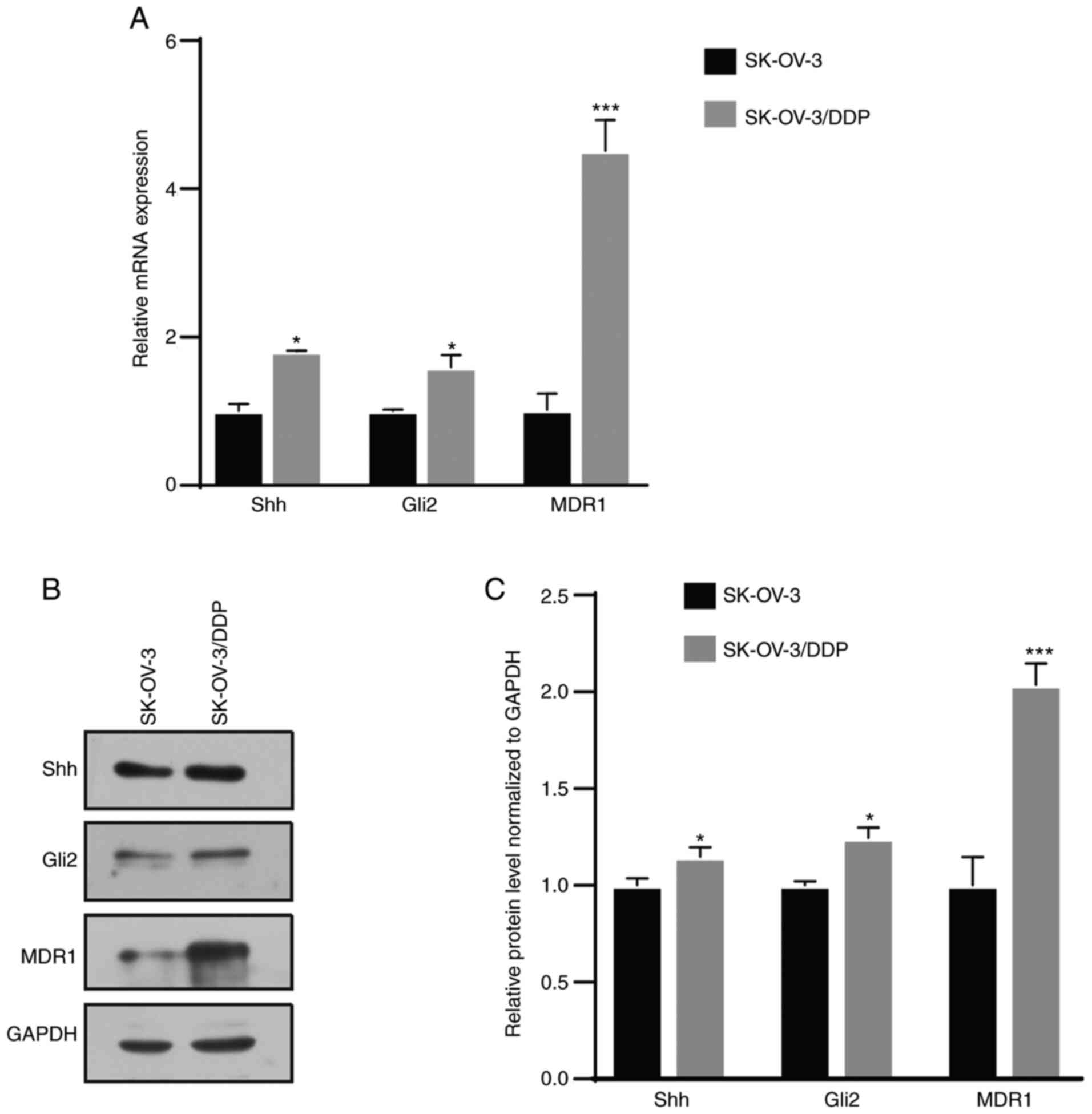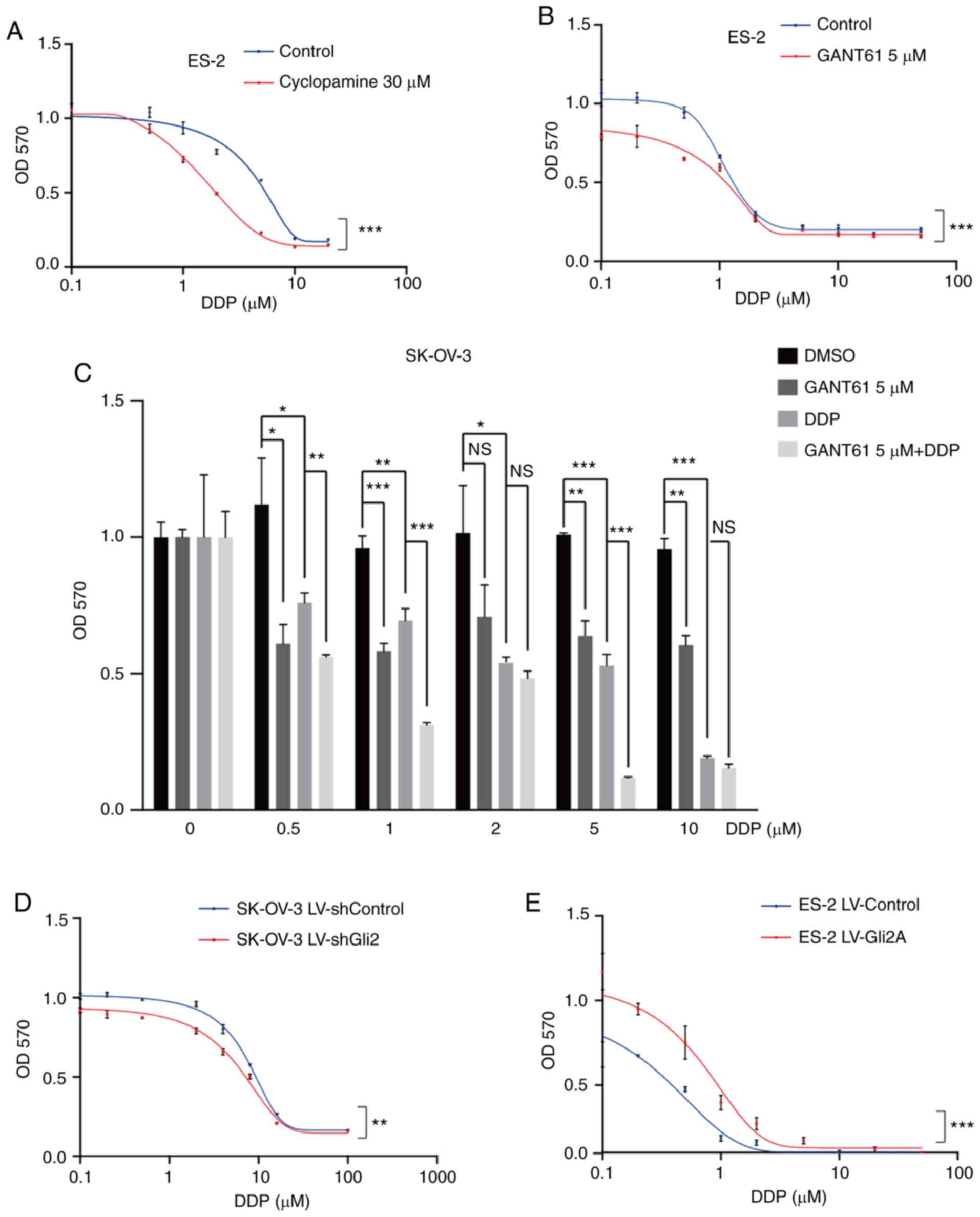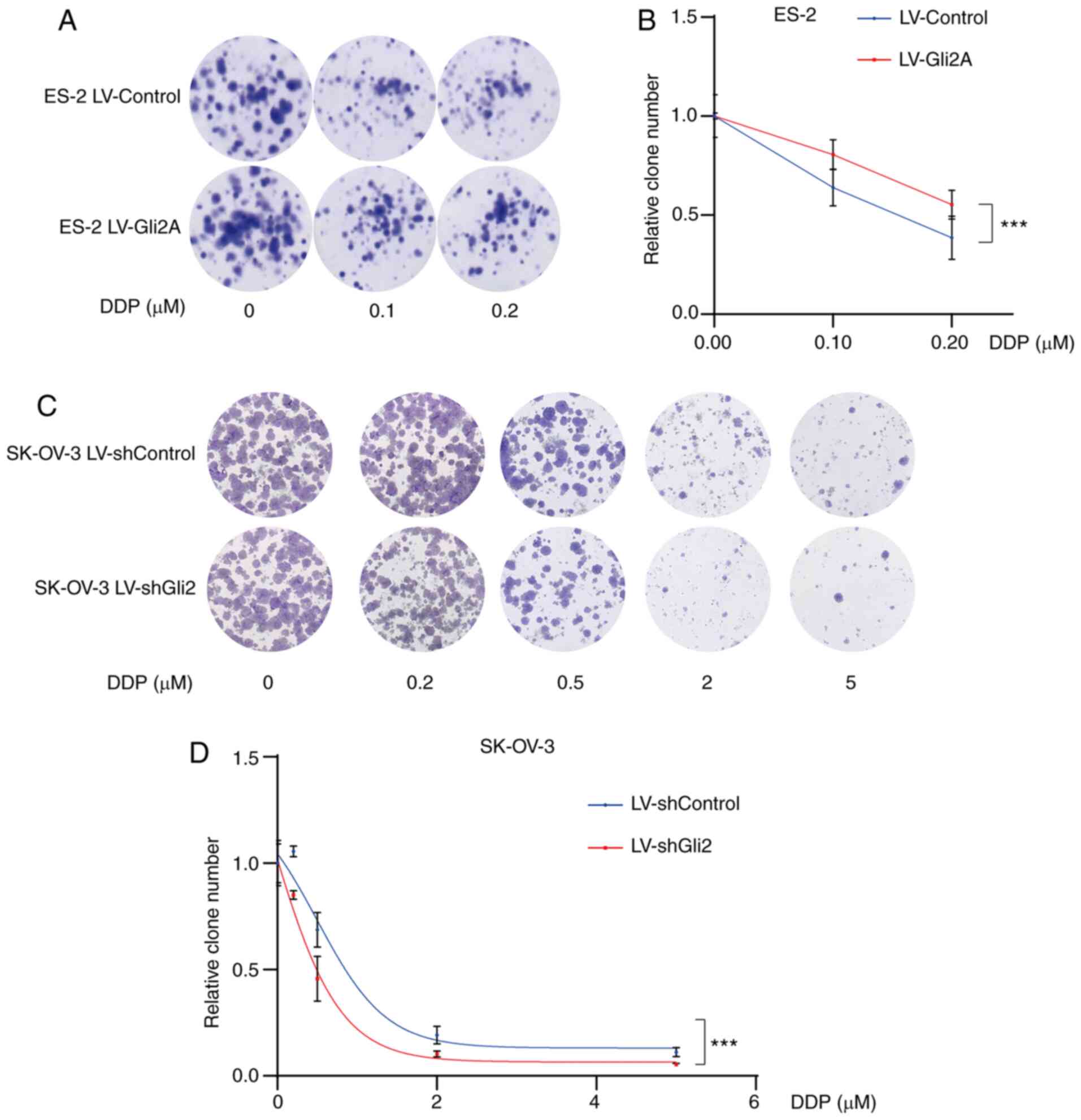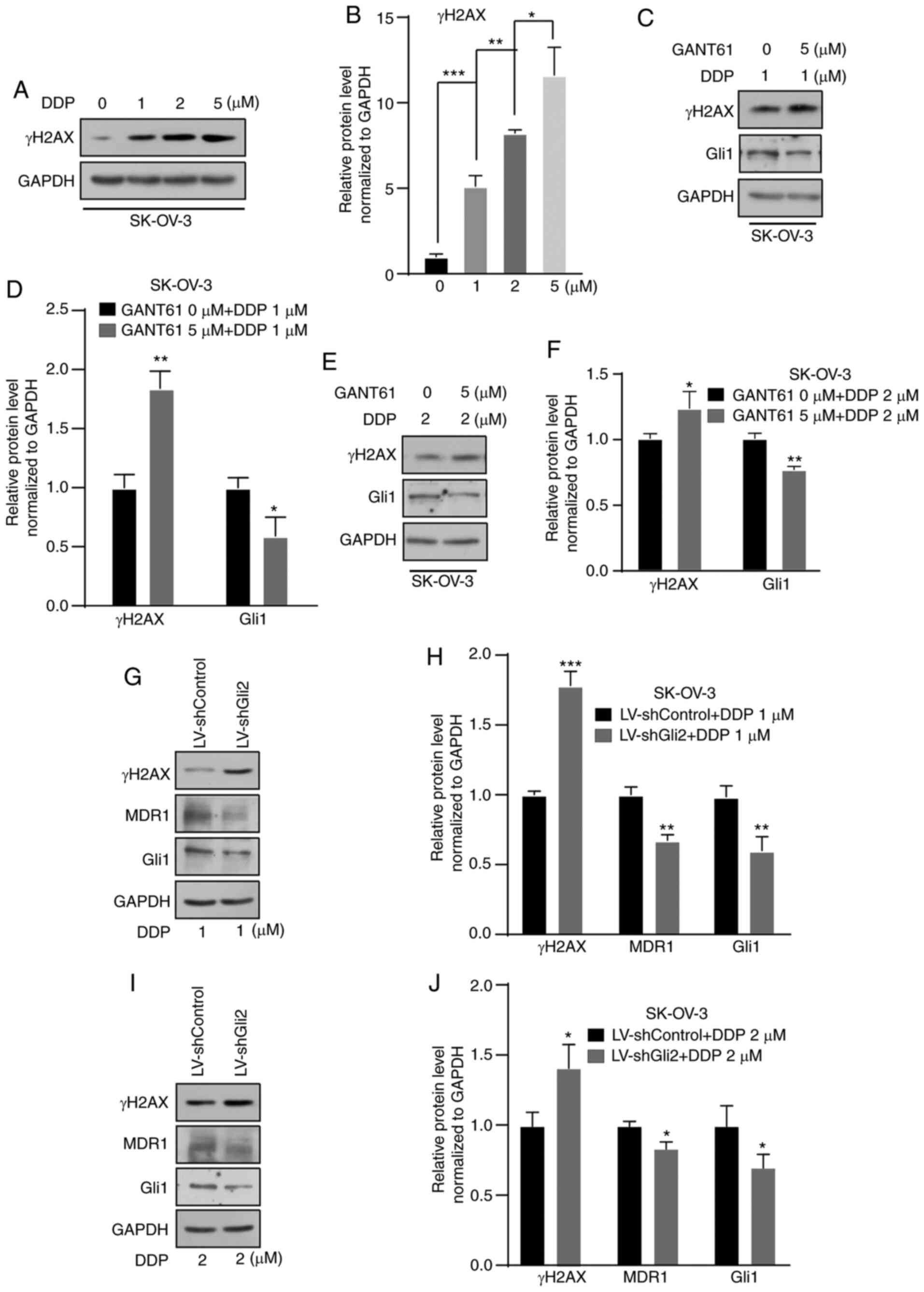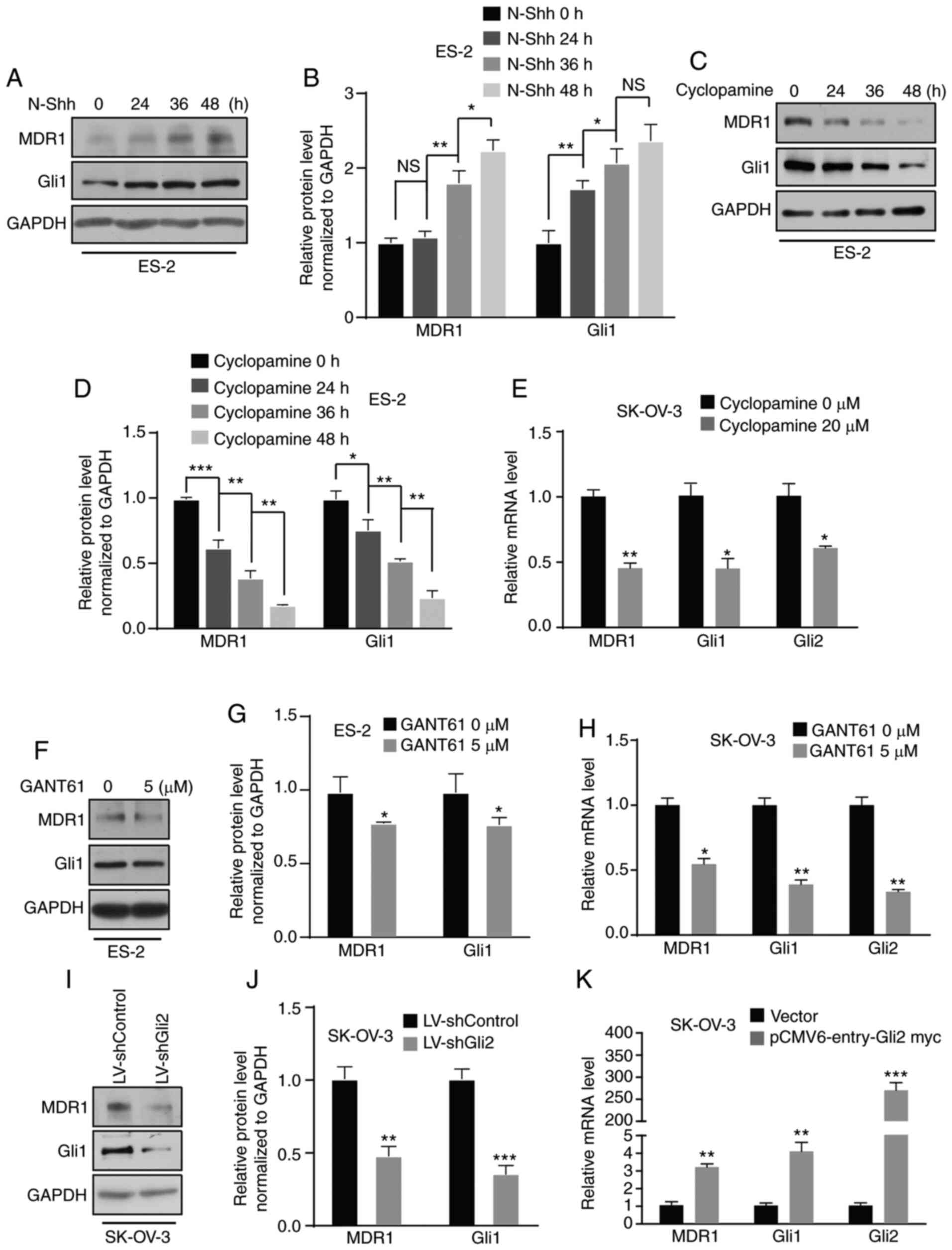|
1
|
Siegel RL, Miller KD and Jemal A: Cancer
statistics, 2019. CA Cancer J Clin. 69:7–34. 2019. View Article : Google Scholar : PubMed/NCBI
|
|
2
|
Bray F, Ferlay J, Soerjomataram I, Siegel
RL, Torre LA and Jemal A: Global cancer statistics 2018: GLOBOCAN
estimates of incidence and mortality worldwide for 36 cancers in
185 countries. CA Cancer J Clin. 68:394–424. 2018. View Article : Google Scholar : PubMed/NCBI
|
|
3
|
Nüsslein-Volhard C and Wieschaus E:
Mutations affecting segment number and polarity in
Drosophila. Nature. 287:795–801. 1980. View Article : Google Scholar : PubMed/NCBI
|
|
4
|
Ingham PW and McMahon AP: Hedgehog
signaling in animal development_ paradigms and princip. Genes Dev.
15:3059–3087. 2001. View Article : Google Scholar : PubMed/NCBI
|
|
5
|
Hui CC and Angers S: Gli proteins in
development and disease. Annu Rev Cell Dev Biol. 27:513–537. 2011.
View Article : Google Scholar : PubMed/NCBI
|
|
6
|
Bakshi A, Chaudhary SC, Rana M, Elmets CA
and Athar M: Basal cell carcinoma pathogenesis and therapy
involving hedgehog signaling and beyond. Mol Carcinog.
56:2543–2557. 2017. View
Article : Google Scholar : PubMed/NCBI
|
|
7
|
Park KS, Martelotto LG, Peifer M, Sos ML,
Karnezis AN, Mahjoub MR, Bernard K, Conklin JF, Szczepny A, Yuan J,
et al: A crucial requirement for hedgehog signaling in small cell
lung cancer. Nat Med. 17:1504–1508. 2011. View Article : Google Scholar : PubMed/NCBI
|
|
8
|
Li H, Li J and Feng L: Hedgehog signaling
pathway as a therapeutic target for ovarian cancer. Cancer
Epidemiol. 40:152–157. 2016. View Article : Google Scholar : PubMed/NCBI
|
|
9
|
Song X, Yan L, Lu C, Zhang C, Zhu F, Yang
J, Jing H, Zhang Y, Qiao J and Guo H: Activation of hedgehog
signaling and its association with cisplatin resistance in ovarian
epithelial tumors. Oncol Lett. 15:5569–5576. 2018.PubMed/NCBI
|
|
10
|
Steg AD, Katre AA, Bevis KS, Ziebarth A,
Dobbin ZC, Shah MM, Alvarez RD and Landen CN: Smoothened
antagonists reverse taxane resistance in ovarian cancer. Mol Cancer
Ther. 11:1587–1597. 2012. View Article : Google Scholar : PubMed/NCBI
|
|
11
|
Liao X, Siu MK, Au CW, Wong ES, Chan HY,
Ip PP, Ngan HY and Cheung AN: Aberrant activation of hedgehog
signaling pathway in ovarian cancers: Effect on prognosis, cell
invasion and differentiation. Carcinogenesis. 30:131–140. 2009.
View Article : Google Scholar : PubMed/NCBI
|
|
12
|
Ben-Hamo R, Zilberberg A, Cohen H,
Bahar-Shany K, Wachtel C, Korach J, Aviel-Ronen S, Barshack I,
Barash D, Levanon K and Efroni S: Resistance to paclitaxel is
associated with a variant of the gene BCL2 in multiple tumor types.
NPJ Precis Oncol. 3:122019. View Article : Google Scholar : PubMed/NCBI
|
|
13
|
Zhang J, Li ZY, Duan XJ, Fan XM, Liu WN
and Li YH: Clinical significance of FOXM1 and gli-1 protein
expression in high-grade ovarian serous carcinoma. Zhonghua Zhong
Liu Za Zhi. 38:904–908. 2016.(In Chinese). PubMed/NCBI
|
|
14
|
Tassi RA, Todeschini P, Siegel ER, Calza
S, Cappella P, Ardighieri L, Cadei M, Bugatti M, Romani C, Bandiera
E, et al: FOXM1 expression is significantly associated with
chemotherapy resistance and adverse prognosis in non-serous
epithelial ovarian cancer patients. J Exp Clin Cancer Res.
36:632017. View Article : Google Scholar : PubMed/NCBI
|
|
15
|
Meng E, Hanna A, Samant RS and Shevde LA:
The impact of hedgehog signaling pathway on DNA repair mechanisms
in human cancer. Cancers (Basel). 7:1333–1348. 2015. View Article : Google Scholar : PubMed/NCBI
|
|
16
|
Huang RL, Gu F, Kirma NB, Ruan J, Chen CL,
Wang HC, Liao YP, Chang CC, Yu MH, Pilrose JM, et al: Comprehensive
methylome analysis of ovarian tumors reveals hedgehog signaling
pathway regulators as prognostic DNA methylation biomarkers.
Epigenetics. 8:624–634. 2014. View Article : Google Scholar
|
|
17
|
Ke Z, Caiping S, Qing Z and Xiaojing W:
Sonic hedgehog-gli1 signals promote epithelial-mesenchymal
transition in ovarian cancer by mediating PI3K/AKT pathway. Med
Oncol. 32:3682015. View Article : Google Scholar : PubMed/NCBI
|
|
18
|
Steg AD, Bevis KS, Katre AA, Ziebarth A,
Dobbin ZC, Alvarez RD, Zhang K, Conner M and Landen CN: Stem cell
pathways contribute to clinical chemoresistance in ovarian cancer.
Clin Cancer Res. 18:869–881. 2012. View Article : Google Scholar : PubMed/NCBI
|
|
19
|
Bossennec M, Di Roio A, Caux C and
Ménétrier-Caux C: MDR1 in immunity: Friend or foe? Oncoimmunology.
7:e14993882018. View Article : Google Scholar : PubMed/NCBI
|
|
20
|
Lu L, Katsaros D, Wiley A, de la Longrais
IA, Puopolo M and Yu H: Expression of MDR1 in epithelial ovarian
cancer and its association with disease progression. Oncol Res.
16:395–403. 2007. View Article : Google Scholar : PubMed/NCBI
|
|
21
|
Vaidyanathan A, Sawers L, Gannon AL,
Chakravarty P, Scott AL, Bray SE, Ferguson MJ and Smith G: ABCB1
(MDR1) induction defines a common resistance mechanism in
paclitaxel- and olaparib-resistant ovarian cancer cells. Br J
Cancer. 115:431–441. 2016. View Article : Google Scholar : PubMed/NCBI
|
|
22
|
Cui D, Xu Q, Wang K and Che X: Gli1 is a
potential target for alleviating multidrug resistance of gliomas. J
Neurol Sci. 288:156–166. 2010. View Article : Google Scholar : PubMed/NCBI
|
|
23
|
Chen Q, Xu R, Zeng C, Lu Q, Huang D, Shi
C, Zhang W, Deng L, Yan R, Rao H, et al: Down-Regulation of gli
transcription factor leads to the inhibition of migration and
invasion of ovarian cancer cells via integrin beta4-mediated FAK
signaling. PLoS One. 9:e883862014. View Article : Google Scholar : PubMed/NCBI
|
|
24
|
Zhang H, Wang Y, Chen T, Zhang Y, Xu R,
Wang W, Cheng M and Chen Q: Aberrant activation of hedgehog
signalling promotes cell migration and invasion via matrix
metalloproteinase-7 in ovarian cancer cells. J Cancer. 10:990–1003.
2019. View Article : Google Scholar : PubMed/NCBI
|
|
25
|
Roessler E, Ermilov AN, Grange DK, Wang A,
Grachtchouk M, Dlugosz AA and Muenke M: A previously unidentified
amino-terminal domain regulates transcriptional activity of
wild-type and disease-associated human GLI2. Hum Mol Genet.
14:2181–2188. 2005. View Article : Google Scholar : PubMed/NCBI
|
|
26
|
Wang D, Hu G, Du Y, Zhang C, Lu Q, Lv N
and Luo S: Aberrant activation of hedgehog signaling promotes cell
proliferation via the transcriptional activation of forkhead Box M1
in colorectal cancer cells. J Exp Clin Cancer Res. 36:232017.
View Article : Google Scholar : PubMed/NCBI
|
|
27
|
Yan R, Peng X, Yuan X, Huang D, Chen J, Lu
Q, Lv N and Luo S: Suppression of growth and migration by blocking
the hedgehog signaling pathway in gastric cancer cells. Cell Oncol
(Dordr). 36:421–435. 2013. View Article : Google Scholar : PubMed/NCBI
|
|
28
|
Guo P, Peng D, Xiong X and Zhang S:
Expression of microRNA-100 and its correlation with drug resistance
in human ovarian cancer SKOV3/DDP cells. Nan Fang Yi Ke Da Xue Xue
Bao. 35:1624–1627. 2015.(In Chinese). PubMed/NCBI
|
|
29
|
Schmittgen TD and Livak KJ: Analyzing
real-time PCR data by the comparative CT method. Nat Protoc.
3:1101–1108. 2008. View Article : Google Scholar : PubMed/NCBI
|
|
30
|
Wang Q, Shi YL, Zhou K, Wang LL, Yan ZX,
Liu YL, Xu LL, Zhao SW, Chu HL, Shi TT, et al: PIK3CA mutations
confer resistance to first-line chemotherapy in colorectal cancer.
Cell Death Dis. 9:7392018. View Article : Google Scholar : PubMed/NCBI
|
|
31
|
Gao ZJ, Yuan WD, Yuan JQ, Yuan K and Wang
Y: Downregulation of HIF-2alpha reverse the chemotherapy resistance
of lung adenocarcinoma A549 cells to cisplatin. Med Sci Monit.
24:1104–1111. 2018. View Article : Google Scholar : PubMed/NCBI
|
|
32
|
Reed E, Larkins TL, Chau CH and Figg WD:
DNA repair: ERCC1, nucleotide excision repair, and platinum
resistance. Handbook of Anticancer Pharmacokinetics and
Pharmacodynamics. Cancer Drug Discovery and Development. Rudek MA,
et al: Springer Science and Business Media; New York: DOI
10.1007/978-1-4614-9135-4_18; pp. 333–349. 2014, View Article : Google Scholar
|
|
33
|
Ding Y, Niu W, Zhang T, Wang J, Cao J,
Chen H, Wang R and An H: Levistolide A synergistically enhances
doxorubicininduced apoptosis of k562/dox cells by decreasing MDR1
expression through the ubiquitin pathway. Oncol Rep. 41:1198–1208.
2018.PubMed/NCBI
|
|
34
|
Zeng C, Chen T, Zhang Y and Chen Q:
Hedgehog signaling pathway regulates ovarian cancer invasion and
migration via adhesion molecule CD24. J Cancer. 8:786–792. 2017.
View Article : Google Scholar : PubMed/NCBI
|
|
35
|
Wiechert A, Saygin C, Thiagarajan PS, Rao
VS, Hale JS, Gupta N, Hitomi M, Nagaraj AB, DiFeo A, Lathia JD and
Reizes O: Cisplatin induces stemness in ovarian cancer. Oncotarget.
7:30511–30522. 2016. View Article : Google Scholar : PubMed/NCBI
|
|
36
|
Barakat MT, Humke EW and Scott MP:
Learning from jekyll to control hyde: Hedgehog signaling in
development and cancer. Trends Mol Med. 16:337–348. 2010.
View Article : Google Scholar : PubMed/NCBI
|
|
37
|
Steg AD, Burke MR, Amm HM, Katre AA,
Dobbin ZC, Jeong DH and Landen CN: Proteasome inhibition reverses
hedgehog inhibitor and taxane resistance in ovarian cancer.
Oncotarget. 5:7065–7080. 2014. View Article : Google Scholar : PubMed/NCBI
|
|
38
|
Ding J, Zhou XT, Zou HY and Wu J: Hedgehog
signaling pathway affects the sensitivity of hepatoma cells to drug
therapy through the ABCC1 transporter. Lab Invest. 97:819–832.
2017. View Article : Google Scholar : PubMed/NCBI
|
|
39
|
Chaudary N, Pintilie M, Hedley D, Hill RP,
Milosevic M and Mackay H: Hedgehog inhibition enhances efficacy of
radiation and cisplatin in orthotopic cervical cancer xenografts.
Br J Cancer. 116:50–57. 2017. View Article : Google Scholar : PubMed/NCBI
|
|
40
|
Yu B, Gu D, Zhang X, Li J, Liu B and Xie
J: GLI1-Mediated regulation of side population is responsible for
drug resistance in gastric cancer. Oncotarget. 8:27412–27427. 2017.
View Article : Google Scholar : PubMed/NCBI
|
|
41
|
Zahreddine HA, Culjkovic-Kraljacic B,
Assouline S, Gendron P, Romeo AA, Morris SJ, Cormack G, Jaquith JB,
Cerchietti L, Cocolakis E, et al: The sonic hedgehog factor GLI1
imparts drug resistance through inducible glucuronidation. Nature.
511:90–93. 2014. View Article : Google Scholar : PubMed/NCBI
|
|
42
|
Amable L: Cisplatin resistance and
opportunities for precision medicine. Pharmacol Res. 106:27–36.
2016. View Article : Google Scholar : PubMed/NCBI
|
|
43
|
Li Q, Yu JJ, Mu C, Yunmbam MK, Slavsky D,
Cross CL, Bostick-Bruton F and Reed E: Association between the
level of ERCC-1 expression and the repair of cisplatin-induced DNA
damage in human ovarian cancer cells. Anticancer Res. 20:645–652.
2000.PubMed/NCBI
|
|
44
|
Laner-Plamberger S, Kaser A, Paulischta M,
Hauser-Kronberger C, Eichberger T and Frischauf AM: Cooperation
between GLI and JUN enhances transcription of JUN and selected GLI
target genes. Oncogene. 28:1639–1651. 2009. View Article : Google Scholar : PubMed/NCBI
|
|
45
|
Kudo K, Gavin E, Das S, Amable L, Shevde
LA and Reed E: Inhibition of gli1 results in altered c-Jun
activation, inhibition of cisplatin-induced upregulation of ERCC1,
XPD and XRCC1, and inhibition of platinum-DNA adduct repair.
Oncogene. 31:4718–4724. 2012. View Article : Google Scholar : PubMed/NCBI
|
|
46
|
Agyeman A, Mazumdar T and Houghton JA:
Regulation of DNA damage following termination of hedgehog (HH)
survival signaling at the level of the GLI genes in human colon
cancer. Oncotarget. 3:854–868. 2012. View Article : Google Scholar : PubMed/NCBI
|
|
47
|
Li J, Cai J, Zhao S, Yao K, Sun Y, Li Y,
Chen L, Li R, Zhai X, Zhang J and Jiang C: GANT61, a GLI inhibitor,
sensitizes glioma cells to the temozolomide treatment. J Exp Clin
Cancer Res. 35:1842016. View Article : Google Scholar : PubMed/NCBI
|
|
48
|
Kuo LJ and Yang LX: γ-H2AX-a novel
biomarker for DNA double-strand breaks. In Vivo. 22:305–310.
2008.PubMed/NCBI
|















